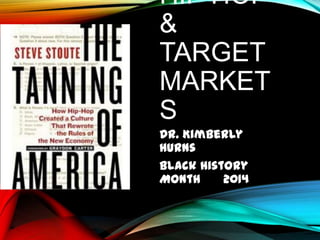Hip hop & target markets
- 1. HIP HOP & TARGET MARKET S Dr. Kimberly Hurns Black History Month 2014
- 2. STEVE STOUTE ? Music Executive ? Has won a variety of professional advertising awards ? Owner of Translation, a transcultural advertising agency ? Partnered with Shawn Carter (Jay-Z) to develop Translation Advertising firm ? His understanding of how hip-hop morphed into mainstream culture enabled him to relate to a new generation of thinking.
- 3. GROUND RULES ? Target markets can sound uncomfortable; racist, negative generalizations ? This is a SAFE place to discuss and learn ? No Judgments!
- 4. CONTEXT ? From 2000 to 2010, the number of Americans who consider themselves multiracial grew faster than those who self-identify as a single race. ? The evolution of how we think about target markets is impacted by social, cultural, economic and political change; and these things impact one another ? And, art and entertainment affect social change, not always the reverse ? We do not often exam race when it comes to business and the selling of products, consumerism
- 5. TARGET MARKETS ? Age ? Race ? Income ? Education ? Geography ? Behavior
- 7. HIP-HOP ( RAP MUSIC ) ? In 1999 Hip-Hop outsold country music ? Music sells took place in illogical zip codes ? Hip-Hop was a cultural explosion happening under the radar ? It was counterculture and therefore ignored and/or criticized ? But, the clash of cultures and generations created mashup that redefined “urban” ? The poetry of hip-hop was global and it propelled brands
- 8. QUESTION ?In general, marketers should not use race to segment markets to advertise products.
- 9. GOAL OF THE BOOK From a marketing standpoint, put an end to “boxing” individuals based on color. Steve Stoute
- 11. MY PROPOSITION Like social enterprises, Capitalism can serve as a tool to promote real inclusion and change!?












